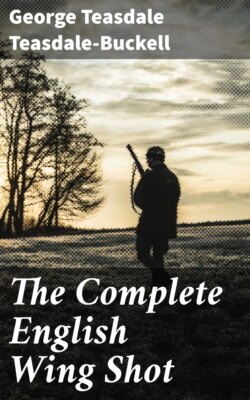Читать книгу The Complete English Wing Shot - George Teasdale Teasdale-Buckell - Страница 10
ОглавлениеEjectors
What has been said of actions applies also to ejectors. If all the patents have not run out, plenty of good ones have done so, and the gun-maker has a great choice and nothing to pay for it.
The principle of the ejector is that with split extractors there is a connection between the fall of the tumbler or hammer and an ejecting mechanism, or lock in the fore end of the gun. The opening or closing of the gun after firing is made to cock the tumblers, strikers, or hammers, and also to put the ejector at full cock, or otherwise bring it ready for action, then when a shot is fired the fallen hammer or tumbler, or its re-cocking, is made to react on the ejector at that stage of the opening gun when the extractors have already moved the empty cartridge-case. The undischarged cartridges are therefore extracted, but not ejected, and the used cases are ejected.
Safety of Guns
The safety bolt placed upon hammerless shot guns is very necessary. It ought, when placed at safety, to prevent the lock springs working, and should prevent the possibility of the scear being released from the catch, or bent, or scear catch. Mr. Robertson, proprietor of Messrs. Boss & Co., has shown conclusively that a slight rap on the lock plates will disconnect any scear catch, and so let off the gun when not at safety, unless it is also protected with an interceptor, which is moved out of the way of the falling tumbler, or striker, only by the pull of the trigger. Mr. Robertson’s own single-trigger action is also a safety action, even when very light trigger pulls, such as 1 lb., are employed.
The strength of barrels is assured by the proof of them at the London, Birmingham, and foreign proof houses, with loads and charges larger than for service. Anyone in doubt about purchasing guns and rifles would be well advised to write to the Proof Master for the literary matter issued for the protection of the public and guidance of the trade. This changes from time to time, but at present it gives very full information of the meaning of the various foreign proof marks as well as of our own.
Cross-Eyed Stocks
It is often suggested that a thumb-stall which stands up and blocks the fore sight from the left eye is an assistance to right-shouldered shooters, and sometimes it is. But as it has no effect on the manner of bringing up the weapon, it must require revision to get the correct aim if the weapon is not brought up correctly. The author thinks that a long course of shutting the left eye will force the right eye into becoming governing eye by habit. Some people have neither eye greatly the governor, so that each has an influence on the manner of the “present,” and helps to fix the point the gun is brought up to. This point may be half-way between the extended lines from the two eyes to the foresight, and permits of no real alignment until the gun is moved after presentation, which is always slow. For such men nothing but shutting one eye will be of much use, but for those who have a controlling left eye it is different, and a cross-eyed stock, or shooting from the left shoulder, is to be recommended. Those who have a control eye need not necessarily be able to see the game with it. Provided they see the latter with one eye and take alignment of the breech and fore sight with the control eye, that is enough. If the eyes are pairs—that is, not crossed—and produce on the brain but one image of an object focused, then the direction of the alignment over or upon the game or target is accomplished in the brain, and the hands obey. That is to say, the left eye may be unable to see the sights, and the right eye may be unable to see the game, but as the images on both are superimposed on the brain the aim is quite correct for normal eyes. A beginner thinks this impossible, but if he uses a thumb-stall, and blocks the fore sight from the left eye, and puts a card over the muzzle, so as to block the right eye from seeing the target, and then focuses the latter, and not the fore sight, he will soon become unconscious that he is blocking out anything from either eye.
As the ability of the eyes has had to be referred to here, it may be well to remark that any normal eyes can see the shot in flight against the sky, and this ability has been used to advantage in coaching shooters. To see this phenomenon, stand slightly behind the shooter, and look for a little darkening of the sky in the direction of the aim; it will be easily seen about the time the shot has spread to a foot, or so, diameter. Whether anyone can see the shot much nearer than 15 yards or farther away than 20 yards is questionable; the spread of the pellets reduces the dark shade-like appearance, and it vanishes. Consequently, experts who see clay birds apparently in the middle of the pellets may be quite correct at short distances, and appearances may be absolutely wrong for game or clay targets at distances farther away than the shot can be detected. The bird may have flown another two yards by the time the shot intersects its line of flight. Consequently, this ability of the coach to see the shot should only be relied upon at about 20 yards range.
